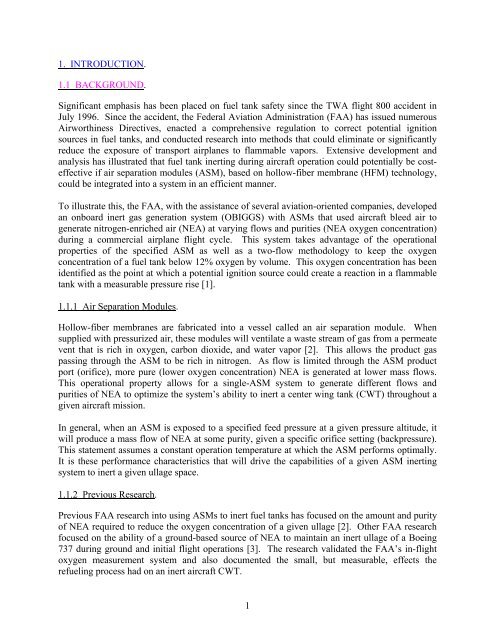Flight-Testing of the FAA Onboard Inert Gas Generation System on ...
Flight-Testing of the FAA Onboard Inert Gas Generation System on ...
Flight-Testing of the FAA Onboard Inert Gas Generation System on ...
Create successful ePaper yourself
Turn your PDF publications into a flip-book with our unique Google optimized e-Paper software.
1. INTRODUCTION.<br />
1.1 BACKGROUND.<br />
Significant emphasis has been placed <strong>on</strong> fuel tank safety since <str<strong>on</strong>g>the</str<strong>on</strong>g> TWA flight 800 accident in<br />
July 1996. Since <str<strong>on</strong>g>the</str<strong>on</strong>g> accident, <str<strong>on</strong>g>the</str<strong>on</strong>g> Federal Aviati<strong>on</strong> Administrati<strong>on</strong> (<str<strong>on</strong>g>FAA</str<strong>on</strong>g>) has issued numerous<br />
Airworthiness Directives, enacted a comprehensive regulati<strong>on</strong> to correct potential igniti<strong>on</strong><br />
sources in fuel tanks, and c<strong>on</strong>ducted research into methods that could eliminate or significantly<br />
reduce <str<strong>on</strong>g>the</str<strong>on</strong>g> exposure <str<strong>on</strong>g>of</str<strong>on</strong>g> transport airplanes to flammable vapors. Extensive development and<br />
analysis has illustrated that fuel tank inerting during aircraft operati<strong>on</strong> could potentially be costeffective<br />
if air separati<strong>on</strong> modules (ASM), based <strong>on</strong> hollow-fiber membrane (HFM) technology,<br />
could be integrated into a system in an efficient manner.<br />
To illustrate this, <str<strong>on</strong>g>the</str<strong>on</strong>g> <str<strong>on</strong>g>FAA</str<strong>on</strong>g>, with <str<strong>on</strong>g>the</str<strong>on</strong>g> assistance <str<strong>on</strong>g>of</str<strong>on</strong>g> several aviati<strong>on</strong>-oriented companies, developed<br />
an <strong>on</strong>board inert gas generati<strong>on</strong> system (OBIGGS) with ASMs that used aircraft bleed air to<br />
generate nitrogen-enriched air (NEA) at varying flows and purities (NEA oxygen c<strong>on</strong>centrati<strong>on</strong>)<br />
during a commercial airplane flight cycle. This system takes advantage <str<strong>on</strong>g>of</str<strong>on</strong>g> <str<strong>on</strong>g>the</str<strong>on</strong>g> operati<strong>on</strong>al<br />
properties <str<strong>on</strong>g>of</str<strong>on</strong>g> <str<strong>on</strong>g>the</str<strong>on</strong>g> specified ASM as well as a two-flow methodology to keep <str<strong>on</strong>g>the</str<strong>on</strong>g> oxygen<br />
c<strong>on</strong>centrati<strong>on</strong> <str<strong>on</strong>g>of</str<strong>on</strong>g> a fuel tank below 12% oxygen by volume. This oxygen c<strong>on</strong>centrati<strong>on</strong> has been<br />
identified as <str<strong>on</strong>g>the</str<strong>on</strong>g> point at which a potential igniti<strong>on</strong> source could create a reacti<strong>on</strong> in a flammable<br />
tank with a measurable pressure rise [1].<br />
1.1.1 Air Separati<strong>on</strong> Modules.<br />
Hollow-fiber membranes are fabricated into a vessel called an air separati<strong>on</strong> module. When<br />
supplied with pressurized air, <str<strong>on</strong>g>the</str<strong>on</strong>g>se modules will ventilate a waste stream <str<strong>on</strong>g>of</str<strong>on</strong>g> gas from a permeate<br />
vent that is rich in oxygen, carb<strong>on</strong> dioxide, and water vapor [2]. This allows <str<strong>on</strong>g>the</str<strong>on</strong>g> product gas<br />
passing through <str<strong>on</strong>g>the</str<strong>on</strong>g> ASM to be rich in nitrogen. As flow is limited through <str<strong>on</strong>g>the</str<strong>on</strong>g> ASM product<br />
port (orifice), more pure (lower oxygen c<strong>on</strong>centrati<strong>on</strong>) NEA is generated at lower mass flows.<br />
This operati<strong>on</strong>al property allows for a single-ASM system to generate different flows and<br />
purities <str<strong>on</strong>g>of</str<strong>on</strong>g> NEA to optimize <str<strong>on</strong>g>the</str<strong>on</strong>g> system’s ability to inert a center wing tank (CWT) throughout a<br />
given aircraft missi<strong>on</strong>.<br />
In general, when an ASM is exposed to a specified feed pressure at a given pressure altitude, it<br />
will produce a mass flow <str<strong>on</strong>g>of</str<strong>on</strong>g> NEA at some purity, given a specific orifice setting (backpressure).<br />
This statement assumes a c<strong>on</strong>stant operati<strong>on</strong> temperature at which <str<strong>on</strong>g>the</str<strong>on</strong>g> ASM performs optimally.<br />
It is <str<strong>on</strong>g>the</str<strong>on</strong>g>se performance characteristics that will drive <str<strong>on</strong>g>the</str<strong>on</strong>g> capabilities <str<strong>on</strong>g>of</str<strong>on</strong>g> a given ASM inerting<br />
system to inert a given ullage space.<br />
1.1.2 Previous Research.<br />
Previous <str<strong>on</strong>g>FAA</str<strong>on</strong>g> research into using ASMs to inert fuel tanks has focused <strong>on</strong> <str<strong>on</strong>g>the</str<strong>on</strong>g> amount and purity<br />
<str<strong>on</strong>g>of</str<strong>on</strong>g> NEA required to reduce <str<strong>on</strong>g>the</str<strong>on</strong>g> oxygen c<strong>on</strong>centrati<strong>on</strong> <str<strong>on</strong>g>of</str<strong>on</strong>g> a given ullage [2]. O<str<strong>on</strong>g>the</str<strong>on</strong>g>r <str<strong>on</strong>g>FAA</str<strong>on</strong>g> research<br />
focused <strong>on</strong> <str<strong>on</strong>g>the</str<strong>on</strong>g> ability <str<strong>on</strong>g>of</str<strong>on</strong>g> a ground-based source <str<strong>on</strong>g>of</str<strong>on</strong>g> NEA to maintain an inert ullage <str<strong>on</strong>g>of</str<strong>on</strong>g> a Boeing<br />
737 during ground and initial flight operati<strong>on</strong>s [3]. The research validated <str<strong>on</strong>g>the</str<strong>on</strong>g> <str<strong>on</strong>g>FAA</str<strong>on</strong>g>’s in-flight<br />
oxygen measurement system and also documented <str<strong>on</strong>g>the</str<strong>on</strong>g> small, but measurable, effects <str<strong>on</strong>g>the</str<strong>on</strong>g><br />
refueling process had <strong>on</strong> an inert aircraft CWT.<br />
1
















